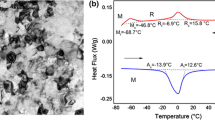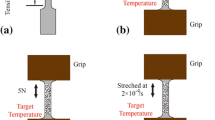Abstract
The cyclic transformation behaviors of polycrystalline super-elastic NiTi shape memory alloys (SMAs) under multiaxial loading paths with different angles between axial and torsional loading orientations were experimentally investigated. The experimental results showed that the start stresses of forward and reverse transformations decreased with the increase in the number of cycles and exhibit obvious anisotropic evolutions. The start stresses of forward and reverse transformations in the tensile and torsional directions did not satisfy the von Mises criterion. The shape of transformation surface during the forward and reverse transformations evolved with the increase in the number of cycles. Then, new cyclic anisotropic transformation surfaces were established by introducing an anisotropic tensor into the von Mises equivalent stress based on a typical transformation criterion related to \(J_2 \) and \(J_3 \). Moreover, the evolution equations of material parameters used in the proposed transformation surfaces were established to describe the subsequent evolutions of transformation surfaces. Finally, the start stresses of forward and reverse transformations predicted using the proposed transformation surfaces were compared with the experimental results. It shows that the proposed transformation surfaces can reasonably describe the start stresses of forward and reverse transformations, which are helpful for establishing a three-dimensional cyclic constitutive model to describe the cyclic transformation behaviors of super-elastic NiTi SMAs.















Similar content being viewed by others
References
Orgéas L, Favier D. Stress-induced martensitic transformation of a NiTi alloy in isothermal shear, tension and compression. Acta Mater. 1998;46(15):5579–91.
Liu Y, Xie Z, Humbeeck JV, Delaey L. Asymmetry of stress–strain curves under tension and compression for NiTi shape memory alloys. Acta Mater. 1998;46(12):4325–38.
Sun QP, Li ZQ. Phase transformation in superelastic NiTi polycrystalline micro-tubes under tension and torsion-from localization to homogeneous deformation. Int J Solids Struct. 2002;39(13):3797–809.
Miyazaki S, Otsuka K, Suzuki Y. Transformation pseudoelasticity and deformation behavior in a Ti-50.6at%Ni alloy. Scr Metall. 1981;15(3):287–92.
Lagoudas DC, Bo Z. Thermomechanical modeling of polycrystalline SMAs under cyclic loading, part II: material characterization and experimental results for a stable transformation cycle. Int J Eng Sci. 1999;37(9):1141–73.
Sehitoglu H, Anderson R, Karaman I, Gall K, Chumlyakov Y. Cyclic deformation behavior of single crystal NiTi. Mater Sci Eng A. 2001;314(1):67–74.
Gall K, Maier HJ. Cyclic deformation mechanisms in precipitated NiTi shape memory alloys. Acta Mater. 2002;50(18):4643–57.
Wang X, Xu B, Yue Z. Phase transformation behavior of pseudoelastic NiTi shape memory alloys under large strain. J Alloys Compd. 2008;463(1):417–22.
Song D, Kang G, Kan Q, Yu C, Zhang C. Non-proportional multiaxial transformation ratchetting of super-elastic NiTi shape memory alloy: experimental observations. Mech Mater. 2014;70(1):94–105.
Lim TJ, Mcdowell DL. Mechanical behavior of an Ni–Ti shape memory alloy under axial-torsional proportional and nonproportional loading. J Eng Mater Technol. 1999;121(1):9–18.
Liu Y, Xie Z, Humbeeck JV. Cyclic deformation of NiTi shape memory alloys. Mater Sci Eng A. 1999;273–275(3):673–8.
Iadicola MA, Shaw JA. The effect of uniaxial cyclic deformation on the evolution of phase transformation fronts in pseudoelastic NiTi wire. J Intell Mater Syst Struct. 2002;13(2):143–55.
Auricchio F, Marfia S, Sacco E. Modelling of SMA materials: training and two way memory effects. Comput Struct. 2003;81(24):2301–17.
Auricchio F, Reali A, Stefanelli U. A three-dimensional model describing stress-induced solid phase transformation with permanent inelasticity. Mech Adv Mater Struct. 2007;14(1):43–55.
Hartl DJ, Chatzigeorgiou G, Lagoudas DC. Three-dimensional modeling and numerical analysis of rate-dependent irrecoverable deformation in shape memory alloys. Int J Plast. 2010;26(10):1485–507.
Lagoudas D, Hartl D, Chemisky Y, Machado L, Popov P. Constitutive model for the numerical analysis of phase transformation in polycrystalline shape memory alloys. Int J Plast. 2012;32–33(2):155–83.
Lagoudas DC, Entchev PB. Modeling of transformation-induced plasticity and its effect on the behavior of porous shape memory alloys. Part I: constitutive model for fully dense SMAs. Mech Mater. 2004;36(9):865–92.
Zaki W, Moumni Z. A 3D model of the cyclic thermomechanical behavior of shape memory alloys. J Mech Phys Solids. 2007;55(11):2427–54.
Zhang X, Yan X, Xie H, Sun R. Modeling evolutions of plastic strain, maximum transformation strain and transformation temperatures in SMA under superelastic cycling. Comput Mater Sci. 2014;81(2):113–22.
Kan Q, Kang G. Constitutive model for uniaxial transformation ratchetting of super-elastic NiTi shape memory alloy at room temperature. Int J Plast. 2010;26(3):441–65.
Saint-Sulpice L, Chirani SA, Calloch S. A 3D super-elastic model for shape memory alloys taking into account progressive strain under cyclic loadings. Mech Mater. 2009;41(1):12–26.
Yu C, Kang G, Kan Q. A physical mechanism based constitutive model for temperature-dependent transformation ratchetting of NiTi shape memory alloy: one-dimensional model. Mech Mater. 2014;78(78):1–10.
James RD, Hane KF. Martensitic transformations and shape-memory materials. Acta Mater. 2000;48(1):197–222.
Wang J, Moumni Z, Zhang W, Xu Y, Zaki W. A 3D finite-strain-based constitutive model for shape memory alloys accounting for thermomechanical coupling and martensite reorientation. Smart Mater Struct. 2017;26(6):065006 (065015pp).
Wang J, Moumni Z, Zhang W. A thermomechanically coupled finite-strain constitutive model for cyclic pseudoelasticity of polycrystalline shape memory alloys. Int J Plast. 2017;97:174–221.
Zhang X, Huang D, Yan X, Zhou X. Modeling functional fatigue of SMA using a more accurate subdivision of martensite volume fractions. Mech Mater. 2016;96:12–29.
Yu C, Kang G, Kan Q, Zhu Y. Rate-dependent cyclic deformation of super-elastic NiTi shape memory alloy: thermo-mechanical coupled and physical mechanism-based constitutive model. Int J Plast. 2015;72:60–90.
Zaki W. An approach to modeling tensile-compressive asymmetry for martensitic shape memory alloys. Smart Mater Struct. 2010;19(2):328–35.
Zaki W, Moumni Z, Morin C. Modeling tensile-compressive asymmetry for superelastic shape memory alloys. Mech Adv Mater Struct. 2011;18(7):559–64.
Auricchio F, Petrini L. A three-dimensional model describing stress-temperature induced solid phase transformations: solution algorithm and boundary value problems. Int J Numer Meth Eng. 2004;61(6):807–36.
Bouvet C, Calloch S, Lexcellent C. Mechanical behavior of a Cu–Al–Be shape memory alloy under multiaxial proportional and nonproportional loadings. J Eng Mater Technol. 2002;124(2):112–24.
Bouvet C, Calloch S, Lexcellent C. A phenomenological model for pseudoelasticity of shape memory alloys under multiaxial proportional and nonproportional loadings. Eur J Mech A Solids. 2004;23(1):37–61.
Saleeb AF, Kumar A, Ii SAP, Dhakal B. The cyclic and evolutionary response to approach the attraction loops under stress controlled isothermal conditions for a multi-mechanism based multi-axial SMA model. Mech Mater. 2013;63(1):21–47.
Acknowledgements
Financial supports by the National Natural Science Foundation of China (11572265; 11532010), the Excellent Youth Found of Sichuan Province (2017JQ0019), the Open Project of Traction Power State Key Laboratory (TPL1606) and the Exploration Project of Traction Power State Key Laboratory (2017TPL_T04) are acknowledged.
Author information
Authors and Affiliations
Corresponding author
Rights and permissions
About this article
Cite this article
Qiu, B., Kan, Q., Zhao, T. et al. Investigation on the Anisotropic Transformation Surfaces of Super-Elastic NiTi Shape Memory Alloys Under Multiaxial Cyclic Loading Conditions. Acta Mech. Solida Sin. 31, 744–757 (2018). https://doi.org/10.1007/s10338-018-0034-6
Received:
Revised:
Accepted:
Published:
Issue Date:
DOI: https://doi.org/10.1007/s10338-018-0034-6




